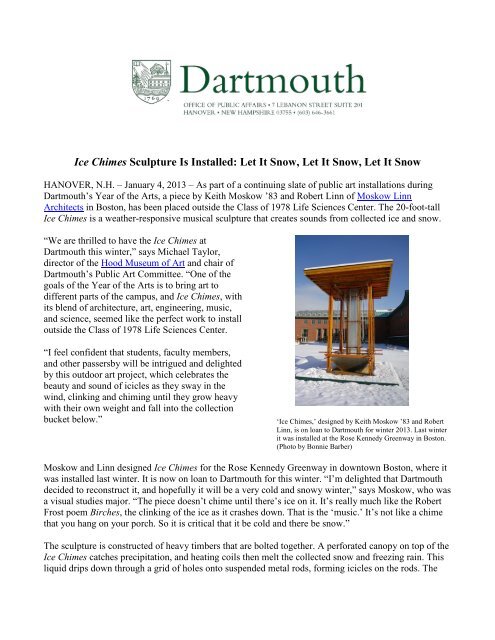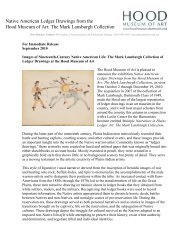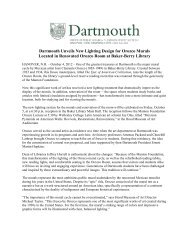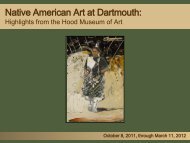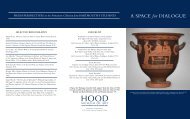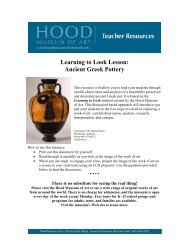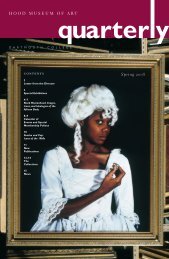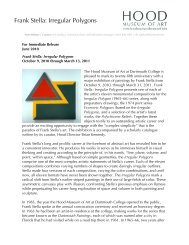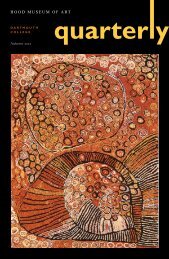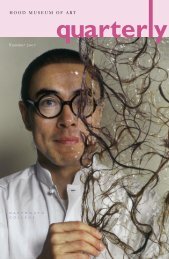Ice Chimes Sculpture Is Installed: Let It Snow, Let It Snow, Let It Snow
Ice Chimes Sculpture Is Installed: Let It Snow, Let It Snow, Let It Snow
Ice Chimes Sculpture Is Installed: Let It Snow, Let It Snow, Let It Snow
Create successful ePaper yourself
Turn your PDF publications into a flip-book with our unique Google optimized e-Paper software.
<strong>Ice</strong> <strong>Chimes</strong> <strong>Sculpture</strong> <strong>Is</strong> <strong>Installed</strong>: <strong>Let</strong> <strong>It</strong> <strong>Snow</strong>, <strong>Let</strong> <strong>It</strong> <strong>Snow</strong>, <strong>Let</strong> <strong>It</strong> <strong>Snow</strong>HANOVER, N.H. – January 4, 2013 – As part of a continuing slate of public art installations duringDartmouth’s Year of the Arts, a piece by Keith Moskow ’83 and Robert Linn of Moskow LinnArchitects in Boston, has been placed outside the Class of 1978 Life Sciences Center. The 20-foot-tall<strong>Ice</strong> <strong>Chimes</strong> is a weather-responsive musical sculpture that creates sounds from collected ice and snow.“We are thrilled to have the <strong>Ice</strong> <strong>Chimes</strong> atDartmouth this winter,” says Michael Taylor,director of the Hood Museum of Art and chair ofDartmouth’s Public Art Committee. “One of thegoals of the Year of the Arts is to bring art todifferent parts of the campus, and <strong>Ice</strong> <strong>Chimes</strong>, withits blend of architecture, art, engineering, music,and science, seemed like the perfect work to installoutside the Class of 1978 Life Sciences Center.“I feel confident that students, faculty members,and other passersby will be intrigued and delightedby this outdoor art project, which celebrates thebeauty and sound of icicles as they sway in thewind, clinking and chiming until they grow heavywith their own weight and fall into the collectionbucket below.”‘<strong>Ice</strong> <strong>Chimes</strong>,’ designed by Keith Moskow ’83 and RobertLinn, is on loan to Dartmouth for winter 2013. Last winterit was installed at the Rose Kennedy Greenway in Boston.(Photo by Bonnie Barber)Moskow and Linn designed <strong>Ice</strong> <strong>Chimes</strong> for the Rose Kennedy Greenway in downtown Boston, where itwas installed last winter. <strong>It</strong> is now on loan to Dartmouth for this winter. “I’m delighted that Dartmouthdecided to reconstruct it, and hopefully it will be a very cold and snowy winter,” says Moskow, who wasa visual studies major. “The piece doesn’t chime until there’s ice on it. <strong>It</strong>’s really much like the RobertFrost poem Birches, the clinking of the ice as it crashes down. That is the ‘music.’ <strong>It</strong>’s not like a chimethat you hang on your porch. So it is critical that it be cold and there be snow.”The sculpture is constructed of heavy timbers that are bolted together. A perforated canopy on top of the<strong>Ice</strong> <strong>Chimes</strong> catches precipitation, and heating coils then melt the collected snow and freezing rain. Thisliquid drips down through a grid of holes onto suspended metal rods, forming icicles on the rods. The
ods sway in the wind, clinking and chiming, until the icicles break off and fall into the metal collectionbucket below, which amplifies the sound and causes reverberations. As the <strong>Ice</strong> <strong>Chimes</strong> website explains,“<strong>It</strong> becomes this constantly changing sculpture with icicles growing and falling and growing again.”The architects say that even if New Englandshould see unseasonably warm weather this winter,<strong>Ice</strong> <strong>Chimes</strong> will still be an engaging sculpture.“The centerpiece glows at night and it has a nicepresence, like a beacon,” says Linn.Moskow and Linn designed the Boston LoganAirport 9/11 Memorial, the Conservation LawFoundation Headquarters in Boston, and theCarroll School in Lincoln, Mass., and numerousresidential projects. They are the recipients of threenational American Institute of Architects awards,and have co-authored five books, includingContemporary Follies, which was published lastmonth; Sustainable Facilities: Green Design,Construction, and Operations; and Small Scale:Creative Solutions for Better City Living.The inside view: A perforated canopy on top of the‘<strong>Ice</strong> <strong>Chimes</strong>’ catches precipitation, and heating coilsthen melt the collected snow and freezing rain. Thisliquid drips down through the grid of holes onto thesesuspended metal rods, forming icicles on the rods.The rods sway in the wind, clinking and chiming,until the icicles break off and fall into the metalcollection bucket below, which amplifies the soundand causes reverberations. (Photo by Bonnie Barber)Moskow, whose wife, Allison, is a member ofDartmouth’s Class of 1985 and son Zack is amember of the Class of 2014, resides in Norwich,Vt., where he and Linn offer a six-day summerworkshop called Studio North for “building smallscalerural interventions.” Moskow says he stillhas many goals to achieve as an architect. “One isto design and build a skyscraper, one is to designand build the perfect teapot, and one is to designand build a major project for Dartmouth. The <strong>Ice</strong><strong>Chimes</strong> is a step in the right direction, but does nottake the Dartmouth project off the list.”Dartmouth’s robust slate of public art installations during the 2012-13 year continues an 80-yeartradition of engaging contemporary artists in the life of the campus and community. Dartmouth’s legacyof public art programming dates back to 1932, when the school commissioned the Mexican artist JoséClemente Orozco to create a mural in Baker Library. The resulting 3,200-square-foot work, The Epic ofAmerican Civilization, is widely recognized as one of the most historically significant murals of the 20thcentury. Since the 1930s, Dartmouth has welcomed more than 150 artists-in-residence to its campus,including such internationally recognized figures as Walker Evans, Donald Judd, R.B. Kitaj, MagdaleneOdundo, Robert Rauschenberg, George Rickey, Alison Saar, and Frank Stella.###
Media ContactsDartmouth College Office of Public Affairs(603) 646-3661 • office.of.public.affairs@dartmouth.eduAbout the Arts at DartmouthDartmouth has long been a leader in integrating the arts into the collegiate experience, from theestablishment of one of the nation’s first campus-based performing arts centers to thecommissioning of new work and promotion of artist-in-residence programs on campus. Dartmouthis reaffirming and deepening its commitment to the arts throughout the 2012-13 academic yearthrough a yearlong series of special programs, events, and initiatives that highlights the centrality ofthe arts as an indispensable component of its educational experience. Major initiatives include theopening of the Black Family Visual Arts Center, the 50th anniversary of the Hopkins Center for theArts, the initiation of an expansion project at the Hood Museum of Art, as well as a series ofprograms exploring the intersections between the arts and other disciplines. Together theseinitiatives reflect and celebrate both the university’s historic commitment to the arts and its role as amodel for the artistic campus of the 21st century.The public art initiative of the Year of the Arts at Dartmouth is made possible in part by the generous support of the Officesof the President and the Provost. For more information, please visit arts.dartmouth.edu.


